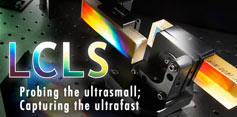

Tuesday - Sepember 2, 2008
SLAC Today is available online at:
http://today.slac.stanford.edu
In this issue:
LCLS Directorate Reorganizes with an Eye on Future Operations
Safety Today: Construction Zones
Travel Reimbursement Deadline
Stanford Graduate Student to Receive Annual SSRL Award
 |
 |
|
Tuesday - Sepember 2, 2008 |
 LCLS Directorate Reorganizes with an Eye on Future OperationsWith Linac Coherent Light Source early science less than a year away, the LCLS organization is evolving to address its next challenge, operating the world's first hard X-ray light source. Last week, LCLS Associate Lab Director Dale Knutson rolled out a new organizational structure for the directorate in an LCLS All-Hands meeting. While still in the final stages of implementation, the new org chart outlines the plan for restructuring and integrating the LCLS organization into one that will best serve a world-class light-source user community. "This is an exciting phase for the lab as the LCLS becomes a reality," said SLAC Director Persis Drell. "Many challenges remain, but restructuring the LCLS Directorate is an important step toward building a world-class research program. SLAC has a very bright future of exciting science ahead." Read more... |
||
|
|
||

Construction Zones
As you walk or drive around SLAC, you have undoubtedly seen the construction zones at the Linac Coherent Light Source site and on Loop Road between South Target Road and Building 33. Like all construction zones, these areas can be dangerous; that's why construction workers wear hard hats, safety glasses, heavy work boots and reflective vests. If you venture into a construction zone without the proper personal protective equipment (PPE), you could be exposed to hazards that could cause injury. Construction zones are barricaded with temporary fencing, other barriers and/or caution tape. These barricades don't actually prevent entry the way a locked door would. Construction workers need to open the barriers to allow trucks, heavy equipment—and themselves—to come and go. At LCLS, the fence will be removed soon. However, LCLS is still an active construction site. Its boundary will be delineated and must be observed. Do not enter a construction zone unless you have business there and you are wearing all of the appropriate PPE: a hard hat, safety glasses, long pants, steel-toed safety boots and a reflective safety vest. If you do need to enter, check in at the site with a SLAC representative or construction supervisor, who will escort you while you conduct your business. We in Environment, Safety and Health recognize the inconvenience of going around rather than through these zones, and we ask that you observe and comply with the barricades and signs for everyone's safety. |
Travel Reimbursement DeadlineSLAC's 2008 fiscal year ends on Tuesday, September 30. Please submit all outstanding Travel Expense Reports to the Travel Office by noon Friday, September 12. Stanford Graduate Student to Receive Annual SSRL Award
Using grazing incidence X-ray diffraction in collaboration with SSRL scientist Michael Toney, Virkar was able to study the sensitivity of organic thin film growth and crystallinity to very small changes in the nature of the surface on which they are deposited. These findings are significant to optimizing organic thin films for next-generation flexible electronics. Virkar also demonstrated how sample preparation and experimental setup effects can often dominate results, findings that will greatly benefit the field of thin film materials science. "I think the success of this project in such a short time had a lot to do with Ajay's persistence, patience, careful observation, intelligence and genuine interest in finding answers to scientific problems," said Zhenan Bao, Associate Professor of Chemical Engineering at Stanford. |
Events (see all | submit)
Access (see all)Announcements
|
| | ||
|
|
||
 <%
Response.AddHeader "Last-modified", getArticleDate()
'Response.AddHeader "Last-modified","Mon, 01 Sep 1997 01:03:33 GMT"
'Monday, December 06, 2010
%>
<%
Response.AddHeader "Last-modified", getArticleDate()
'Response.AddHeader "Last-modified","Mon, 01 Sep 1997 01:03:33 GMT"
'Monday, December 06, 2010
%>View online at http://today.slac.stanford.edu/ |
||